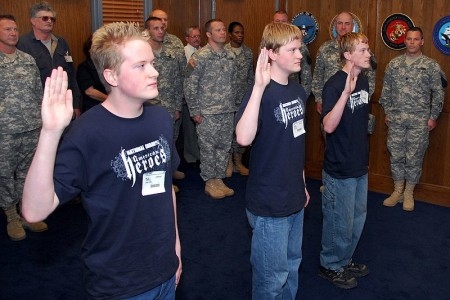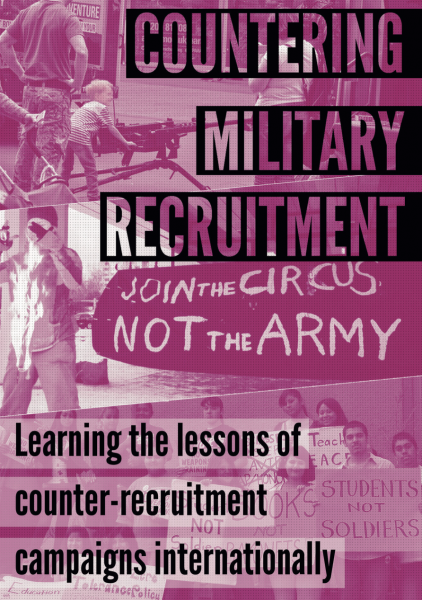Military in Schools in the United States

Oskar Castro
Every year in the United States, millions of young people are faced with the difficult challenge of figuring out what to do with their lives after they graduate from high school. For various reasons, many of them end up considering joining the US Armed Forces, but the commonality among all of those who enlist and those who don’t enlist is that they are all regularly bombarded with military recruitment propaganda pretty much from the time they are born. Whether it is on their television, their computer, at the toy store, or in their classroom, the pitch to embrace the military is everywhere.
The end of World War II saw the United States emerge as a military powerhouse due to the significant role it played in the defeat of Nazi Germany, fascist Italy, and imperial Japan. Then the Cold War materialised which meant that the perceived threat of communism by way of the powerful Soviet Union had to be met with a show of incredible force. The military propaganda machine ratcheted up and the once neutral nation was now a militaristic monstrosity with an ever-growing military industrial complex benefiting from the fear.
The increasing militaristic fervour in the US fueled the efforts to paint the military as the nation’s only defence against communism. Indeed, this ideological feud with the Soviet Union provided the US military with opportunities to fight proxy wars with battlefields emerging in Korea and Southeast Asia. School children were constantly barraged with patriotic, pro-military propaganda meant to insure support for the wars the US military was engaged in, and compliance with conscription. Shortly after the end of the US war in Vietnam, the military draft ended. This meant that the military was now an “all volunteer” force. Without a draft the US military had to embark on a campaign to recruit young people in ways it never had to before.
Arguably the best and most immediate way for the US military to use public high schools as feeder institutions is through the administration of the Armed Services Vocational Aptitude Battery (ASVAB) which is the test every potential recruit must pass before they can move along in their enlistment process. More than 14,000 high schools nationwide give the test to students, and the test is designed to determine whether or not a potential recruit is qualified for the military and also what particular military jobs fit their aptitude. The US military claims the test will help a person choose a civilian career even though that is not what it was designed for. This “transferability” is what is used to paint the ASVAB as a multi-purpose career guidance tool which is offered to schools for free.
The military uses ASVAB to do targeted recruitment of young people, and military recruiters give special attention to students in the 11th or 12th grade who meet minimum standards – what they refer to as “pre-qualified leads”. They use test information (scores, name, address, etc) to identify and directly reach young people they hope to sign up. Using the collected data, military recruiters contact these young people by letters, phone calls, and visits to home and school. Unfortunately, many of the underage students who take the test are never told the test is voluntary and are often misled into signing the privacy waivers that only their parents are legally supposed to sign which means that many parents never actually know that their children have taken this test.
Another way in which the US military recruits young people is by way of its Junior Reserve Officer Training (JROTC) programme which can be found in public high schools throughout the country. JROTC was initiated as a readiness programme for the US war effort in World War I. The programme was designed to prepare young men who were in high school for the eventuality of being in a military environment. In the modern context — and despite the claims that it is simply a discipline, leadership and citizenship building programme — the programme is still used to recruit hearts and minds. The programme involves youth attending classes in military uniforms, learning military science and discipline taught by retired military. Some programmes even include a marksmanship component using guns. Former Secretary of Defense William Cohen, who served in Bill Clinton’s administration, has been quoted as saying about JROTC that it is “one of the best recruiting devices that we could have”. Another Department of Defense official admitted that JROTC graduates who enlist are “roughly five times greater than the proportion of non-JROTC students”. Despite these sorts of admissions made by high officials, the military and other advocates of the programme continue to say that JROTC is not a recruiting tool for the military.
When the military draft ended in the 1970s it happened during a period when the perception of the nation’s military was at an all time low due to its questionable involvement in Southeast Asia. When the US military transformed into an all-volunteer force it realised that it could not clean up its tarnished image on its own and tactically contracted the assistance of Madison Avenue public relations firms to help them figure out how the different military service branches should be advertising in order to recruit young people. Over time it has nuanced its approach and attempted to stay in touch with the times as technology and media have rapidly evolved in the last 40 years.
One of the most interesting if not morally challenging ways for the US military to sell itself to young people is through video games. For many years the US military has assisted for-profit video game developers in creating “first person shooter” games that have a war-based theme. In fact, the US military has been using computer generated simulations since the late 1970s to train its members, and developers who have created games such as “Modern Warfare”, “Call of Duty”, “Ghost Recon”, and “Project Flashpoint” have used retired and active duty military advisers to help add a level of authenticity to games that game developers without military experience couldn’t create on their own. Recently the United States Army spent millions of dollars to develop “America’s Army” for the PC platform in partnership with the software giant Ubisoft.
Originally this game was made available free via server downloads and CD Rom distribution by military recruiters. It was designed to not only capture the information of the potential “gamer” but to track their proficiency as they played the game in a multi-player universe so that targeted recruitment could occur. The game is now available for use on the Xbox and can be bought at major game retail chains in the US.
While this video game phenomenon may not appear to be explicitly related to on- campus recruitment of high school aged youth, it is something that an Army recruiter would have in their bag of tricks when visiting a high school campus. There are times, however, when the military and particularly the Army rolls out a fleet of 18-wheel trucks that transform into mobile arcades stocked with various war themed video games and weapon simulators that children are allowed to play. Sometimes these vehicles do wind up on high school campuses and it is not uncommon for other military vehicles, such as Blackhawk helicopters, to visit high schools and take impressionable youth for military flavoured joy rides.
With more than US$4 billion dollars spent every year to enable these and other types of military recruiting practices to occur in and around public high schools it may be easy for one to think that this encroachment goes unchecked and unchallenged. The reality is that one of the fastest growing movements has been the counter-recruitment/truth-in-recruitment movement that got a big nudge at the onset of the US invasion of Iraq. While this movement began in the mid to late 1980s, it has only been recently that thousands of individuals in the US and hundreds of organisations have begun to take on this type of activism in order to ensure that young people are not lured in by deceptive tactics. For more information and to learn about this ever growing movement one can visit www.nnomy.org.
Countering Military Recruitment

WRI's new booklet, Countering Military Recruitment: Learning the lessons of counter-recruitment campaigns internationally, is out now. The booklet includes examples of campaigning against youth militarisation across different countries with the contribution of grassroot activists.
You can order a paperback version here.







